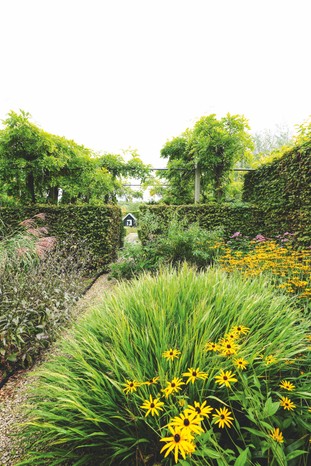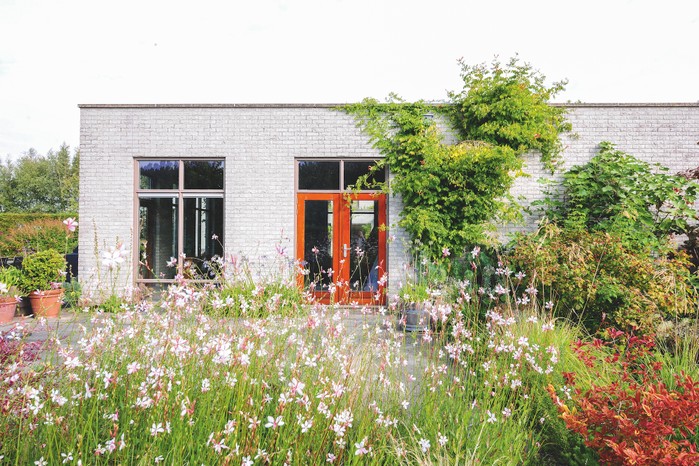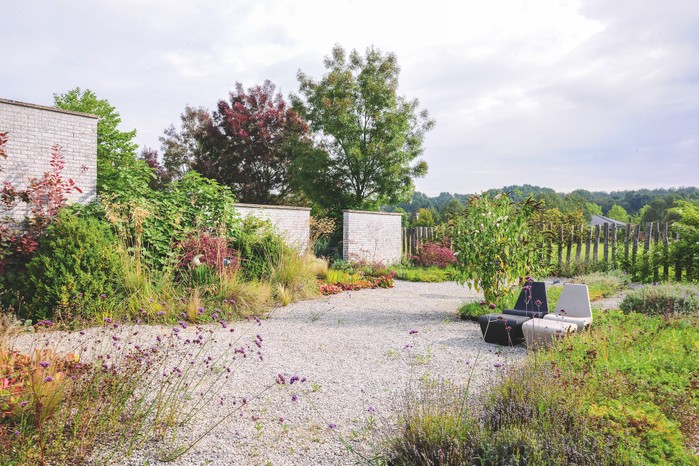
A garden fit for a modernist house
To complement her slick modernist house, Jikke Hamerpagt's garden is a surprisingly colourful mix of garden rooms - with careful detailing throughout.
What: Locus Flevum - garden designer and architect's garden, made up of a series of compartments
Where: the Netherlands
Size: half an acre
Climate: Mild and wet
Soil: Rich and free-draining
Hardiness rating: USDA8
Jikke Hamerpagt and her architect husband, Lucien, bought the land on which their house and garden now stands in 1998. Lucien's design for the house is modernist in style but generous towards the garden and its spaces. This is because house and garden were created in tandem and are even maintained as such, for example the yew and hornbeam hedges that provide structure throughout are clipped precisely to the height of the tops of the windows.

The yellow flowers of Rudbeckia fulgida sing out against the lush, green leaves of Hakonechloa macra. A gap in the beech hedging reveals an ornamental chicken coup at the end of the garden.

Naturalistic planting has been used to enhance rather than obscure the architectural lines of the modernist house (as counselled by, among others, Gertrude Jekyll). The design shows off the affinities between the house and the garden.

Jikke and Lucien chose this site for their home, partly because of the countryside in which it sits. The agricultural land, visible here beyond the chestnut palings, contrasts with the manicured precision of the architect0designed walls and gravel courtyard.

The garden sees a constant play between the contrasting tone or orderly design, such as the pergola and the trio of pots placed along the terrace, and the unfettered appeal of the planting.

Jikke tidies the plantings on the garden's central axis. Here, as elsewhere in the garden, she has deliberately kept the design lopsided or asymmetrical to make the planting 'more exciting'.

Large borders next to the pool and gravelled terrace, create a soft contrast to the sharp lines of the house. A dead tree (this particular spot has proved difficult for trees) painted pink, adds a quirky focal point in contrast to the house.
More like this
You can have a garden filled with 2,000 plants and it's still not a beautiful garden. With my borders I am trying to create character - it may be a kind of sweetness with certain plants, or else a toughness or a character that suits a shaded part

A long, formal pool links the house, with its clean modernist lines, to the undulation of this mixed border overflowing with plants, including tall, pink eupatorium, yellow rudbeckia and miscanthus species.

Red-edged bergenia leaves, alongside tall Stipa gigantea and fluffy S. tenuissima, line one side of a path with white-flowered Gaura lindheimeri beneath a Morus nigra tree on the other. The gravel garden was inspired by Beth Chatto's garden, although its structure owes much to the Dutch garden designer Mien Ruys.
Design lessons to learn
• It is always worth making a terrace that is much more generously sized than you may feel you need. A feeling of expansiveness creates a luxurious and relaxing atmosphere.
• Climbers, such as Vitis vinifera, are often best used in moderation so they can emphasise the characteristics of the architecture as opposed to simply smothering it.
• By varying the materials you use for hard landscaping you can create moments of dramatic contrast, even in a small garden.
• Fencing is sometimes an unconsidered element in the design of even good gardens. In Jikke's garden the chestnut staking, also used by local farmers, is deployed to subtle effect.
• Pots used in clusters with identical plantings can strike an effective note in an architectural courtyard or otherwise formal setting.
• Consider creating simple gaps in walls or hedges rather than doorways or gates - a gap creates a view through, not a barrier, and seems to beckon the visitor on.
Words Tim Richardson
Photographs Sietske de Vries

Niwaki bundle worth £57 when you subscribe
Subscribe to Gardens Illustrated magazine and claim your Niwaki bundle worth £57
*UK only

Container Gardening Special Edition
The Gardens Illustrated Guide to Container Gardening.
In this special edition, discover colourful flower combinations and seasonal planting schemes for pots designed by leading plantspeople, and essential know-how for container gardening success. Just £9.99 inc UK p&pBy entering your details, you are agreeing to our terms and conditions and privacy policy. You can unsubscribe at any time.

Gardens of the Globe
From botanical wonders in Australia to tranquil havens closer to home in Ireland, let this guide help you to discover some of the most glorious gardens around the world
By entering your details, you are agreeing to our terms and conditions and privacy policy. You can unsubscribe at any time.




